MA3-070
antibody from Invitrogen Antibodies
Targeting: KPNB1
IMB1, Impnb, IPO1, IPOB, MGC2155, MGC2156, MGC2157, NTF97
Antibody data
- Antibody Data
- Antigen structure
- References [28]
- Comments [0]
- Validations
- Western blot [3]
- Immunocytochemistry [5]
- Immunoprecipitation [1]
- Flow cytometry [6]
- Other assay [3]
Submit
Validation data
Reference
Comment
Report error
- Product number
- MA3-070 - Provider product page

- Provider
- Invitrogen Antibodies
- Product name
- Importin beta-1 Monoclonal Antibody (3E9)
- Antibody type
- Monoclonal
- Antigen
- Purifed from natural sources
- Description
- MA3-070 detects Importin beta 1 from human, canine, bovine, rat and mouse tissues as well as porcine cell lysates. Importin beta 1 is also known as NTF97, Nuclear Transport Factor p97, and karyopherin beta 1. This antibody does not detect bacterially expressed recombinant NTF97. MA3-070 has been successfully used in Western blot, immunofluorescence, and immunoprecipitation procedures. By Western blot, this antibody detects a single ~97 kDa protein representing NTF97 in MDBK cell homogenate. Immunofluorescence staining of NTF97 in MDBK cells with MA3-070 results in the labeling of both the nuclear envelope (NE) and the cytoplasm and shows discontinuous, punctate staining along the rim of the NE. This antibody can inhibit import of nuclear localization sequence-containing proteins in permeabilized cells. The MA3-070 antigen is purified NTF97 from bovine erythrocytes.
- Reactivity
- Human, Mouse, Rat, Bovine, Canine, Porcine
- Host
- Mouse
- Isotype
- IgG
- Antibody clone number
- 3E9
- Vial size
- 100 μg
- Concentration
- 1 mg/mL
- Storage
- -20°C, Avoid Freeze/Thaw Cycles
Submitted references Unconventional tonicity-regulated nuclear trafficking of NFAT5 mediated by KPNB1, XPOT and RUVBL2.
Effect of Different Nuclear Localization Signals on the Subcellular Localization and Anti-HIV-1 Function of the MxB Protein.
O-GlcNAc modification of nuclear pore complexes accelerates bidirectional transport.
HIV-1 resists MxB inhibition of viral Rev protein.
A potent CBP/p300-Snail interaction inhibitor suppresses tumor growth and metastasis in wild-type p53-expressing cancer.
Differential Roles of Cysteinyl Cathepsins in TGF-β Signaling and Tissue Fibrosis.
Selenite targets eIF4E-binding protein-1 to inhibit translation initiation and induce the assembly of non-canonical stress granules.
Importin beta interacts with the endoplasmic reticulum-associated degradation machinery and promotes ubiquitination and degradation of mutant alpha1-antitrypsin.
Localization of retinitis pigmentosa 2 to cilia is regulated by Importin beta2.
Nuclear entry of activated MAPK is restricted in primary ovarian and mammary epithelial cells.
Modulation of integrin-linked kinase nucleo-cytoplasmic shuttling by ILKAP and CRM1.
A novel mechanism of E2F1 regulation via nucleocytoplasmic shuttling: determinants of nuclear import and export.
HuD distribution changes in response to heat shock but not neurotrophic stimulation.
Multiple importins function as nuclear transport receptors for the Rev protein of human immunodeficiency virus type 1.
The N-terminal domain of the mammalian nucleoporin p62 interacts with other nucleoporins of the FXFG family during interphase.
Vimentin-dependent spatial translocation of an activated MAP kinase in injured nerve.
Enhanced intracellular mobility and nuclear accumulation of DNA plasmids associated with a karyophilic protein.
Novel nuclear herniations induced by nuclear localization of a viral protein.
Sugar-dependent nuclear import of glycosylated proteins in living cells.
An immunohistochemical approach to monitor the prolactin-induced activation of the JAK2/STAT5 pathway in pancreatic islets of Langerhans.
Exercise training attenuates coronary smooth muscle phenotypic modulation and nuclear Ca2+ signaling.
Importin beta-mediated nuclear import of fibroblast growth factor receptor: role in cell proliferation.
Herpes simplex virus type 1 entry into host cells: reconstitution of capsid binding and uncoating at the nuclear pore complex in vitro.
Ran-independent nuclear import of cyclin B1-Cdc2 by importin beta.
Ran-independent nuclear import of cyclin B1-Cdc2 by importin beta.
Nucleocytoplasmic shuttling factors including Ran and CRM1 mediate nuclear export of NFAT In vitro.
Nucleocytoplasmic shuttling factors including Ran and CRM1 mediate nuclear export of NFAT In vitro.
Sequence and characterization of cytoplasmic nuclear protein import factor p97.
Cheung CY, Huang TT, Chow N, Zhang S, Zhao Y, Chau MP, Chan WC, Wong CCL, Boassa D, Phan S, Ellisman MH, Yates JR, Xu S, Yu Z, Zhang Y, Zhang R, Ng LL, Ko BCB
Journal of cell science 2022 Jul 1;135(13)
Journal of cell science 2022 Jul 1;135(13)
Effect of Different Nuclear Localization Signals on the Subcellular Localization and Anti-HIV-1 Function of the MxB Protein.
Chai K, Wang Z, Pan Q, Tan J, Qiao W, Liang C
Frontiers in microbiology 2021;12:675201
Frontiers in microbiology 2021;12:675201
O-GlcNAc modification of nuclear pore complexes accelerates bidirectional transport.
Yoo TY, Mitchison TJ
The Journal of cell biology 2021 Jul 5;220(7)
The Journal of cell biology 2021 Jul 5;220(7)
HIV-1 resists MxB inhibition of viral Rev protein.
Wang Z, Chai K, Liu Q, Yi DR, Pan Q, Huang Y, Tan J, Qiao W, Guo F, Cen S, Liang C
Emerging microbes & infections 2020 Dec;9(1):2030-2045
Emerging microbes & infections 2020 Dec;9(1):2030-2045
A potent CBP/p300-Snail interaction inhibitor suppresses tumor growth and metastasis in wild-type p53-expressing cancer.
Li HM, Bi YR, Li Y, Fu R, Lv WC, Jiang N, Xu Y, Ren BX, Chen YD, Xie H, Wang S, Lu T, Wu ZQ
Science advances 2020 Apr;6(17):eaaw8500
Science advances 2020 Apr;6(17):eaaw8500
Differential Roles of Cysteinyl Cathepsins in TGF-β Signaling and Tissue Fibrosis.
Zhang X, Zhou Y, Yu X, Huang Q, Fang W, Li J, Bonventre JV, Sukhova GK, Libby P, Shi GP
iScience 2019 Sep 27;19:607-622
iScience 2019 Sep 27;19:607-622
Selenite targets eIF4E-binding protein-1 to inhibit translation initiation and induce the assembly of non-canonical stress granules.
Fujimura K, Sasaki AT, Anderson P
Nucleic acids research 2012 Sep;40(16):8099-110
Nucleic acids research 2012 Sep;40(16):8099-110
Importin beta interacts with the endoplasmic reticulum-associated degradation machinery and promotes ubiquitination and degradation of mutant alpha1-antitrypsin.
Zhong Y, Wang Y, Yang H, Ballar P, Lee JG, Ye Y, Monteiro MJ, Fang S
The Journal of biological chemistry 2011 Sep 30;286(39):33921-30
The Journal of biological chemistry 2011 Sep 30;286(39):33921-30
Localization of retinitis pigmentosa 2 to cilia is regulated by Importin beta2.
Hurd TW, Fan S, Margolis BL
Journal of cell science 2011 Mar 1;124(Pt 5):718-26
Journal of cell science 2011 Mar 1;124(Pt 5):718-26
Nuclear entry of activated MAPK is restricted in primary ovarian and mammary epithelial cells.
Smith ER, Cai KQ, Smedberg JL, Ribeiro MM, Rula ME, Slater C, Godwin AK, Xu XX
PloS one 2010 Feb 18;5(2):e9295
PloS one 2010 Feb 18;5(2):e9295
Modulation of integrin-linked kinase nucleo-cytoplasmic shuttling by ILKAP and CRM1.
Nakrieko KA, Vespa A, Mason D, Irvine TS, D'Souza SJ, Dagnino L
Cell cycle (Georgetown, Tex.) 2008 Jul 15;7(14):2157-66
Cell cycle (Georgetown, Tex.) 2008 Jul 15;7(14):2157-66
A novel mechanism of E2F1 regulation via nucleocytoplasmic shuttling: determinants of nuclear import and export.
Ivanova IA, Vespa A, Dagnino L
Cell cycle (Georgetown, Tex.) 2007 Sep 1;6(17):2186-95
Cell cycle (Georgetown, Tex.) 2007 Sep 1;6(17):2186-95
HuD distribution changes in response to heat shock but not neurotrophic stimulation.
Burry RW, Smith CL
The journal of histochemistry and cytochemistry : official journal of the Histochemistry Society 2006 Oct;54(10):1129-38
The journal of histochemistry and cytochemistry : official journal of the Histochemistry Society 2006 Oct;54(10):1129-38
Multiple importins function as nuclear transport receptors for the Rev protein of human immunodeficiency virus type 1.
Arnold M, Nath A, Hauber J, Kehlenbach RH
The Journal of biological chemistry 2006 Jul 28;281(30):20883-20890
The Journal of biological chemistry 2006 Jul 28;281(30):20883-20890
The N-terminal domain of the mammalian nucleoporin p62 interacts with other nucleoporins of the FXFG family during interphase.
Stochaj U, Bański P, Kodiha M, Matusiewicz N
Experimental cell research 2006 Aug 1;312(13):2490-9
Experimental cell research 2006 Aug 1;312(13):2490-9
Vimentin-dependent spatial translocation of an activated MAP kinase in injured nerve.
Perlson E, Hanz S, Ben-Yaakov K, Segal-Ruder Y, Seger R, Fainzilber M
Neuron 2005 Mar 3;45(5):715-26
Neuron 2005 Mar 3;45(5):715-26
Enhanced intracellular mobility and nuclear accumulation of DNA plasmids associated with a karyophilic protein.
Mesika A, Kiss V, Brumfeld V, Ghosh G, Reich Z
Human gene therapy 2005 Feb;16(2):200-8
Human gene therapy 2005 Feb;16(2):200-8
Novel nuclear herniations induced by nuclear localization of a viral protein.
Hoyt CC, Bouchard RJ, Tyler KL
Journal of virology 2004 Jun;78(12):6360-9
Journal of virology 2004 Jun;78(12):6360-9
Sugar-dependent nuclear import of glycosylated proteins in living cells.
Rondanino C, Bousser MT, Monsigny M, Roche AC
Glycobiology 2003 Jul;13(7):509-19
Glycobiology 2003 Jul;13(7):509-19
An immunohistochemical approach to monitor the prolactin-induced activation of the JAK2/STAT5 pathway in pancreatic islets of Langerhans.
Brelje TC, Svensson AM, Stout LE, Bhagroo NV, Sorenson RL
The journal of histochemistry and cytochemistry : official journal of the Histochemistry Society 2002 Mar;50(3):365-83
The journal of histochemistry and cytochemistry : official journal of the Histochemistry Society 2002 Mar;50(3):365-83
Exercise training attenuates coronary smooth muscle phenotypic modulation and nuclear Ca2+ signaling.
Wamhoff BR, Bowles DK, Dietz NJ, Hu Q, Sturek M
American journal of physiology. Heart and circulatory physiology 2002 Dec;283(6):H2397-410
American journal of physiology. Heart and circulatory physiology 2002 Dec;283(6):H2397-410
Importin beta-mediated nuclear import of fibroblast growth factor receptor: role in cell proliferation.
Reilly JF, Maher PA
The Journal of cell biology 2001 Mar 19;152(6):1307-12
The Journal of cell biology 2001 Mar 19;152(6):1307-12
Herpes simplex virus type 1 entry into host cells: reconstitution of capsid binding and uncoating at the nuclear pore complex in vitro.
Ojala PM, Sodeik B, Ebersold MW, Kutay U, Helenius A
Molecular and cellular biology 2000 Jul;20(13):4922-31
Molecular and cellular biology 2000 Jul;20(13):4922-31
Ran-independent nuclear import of cyclin B1-Cdc2 by importin beta.
Takizawa CG, Weis K, Morgan DO
Proceedings of the National Academy of Sciences of the United States of America 1999 Jul 6;96(14):7938-43
Proceedings of the National Academy of Sciences of the United States of America 1999 Jul 6;96(14):7938-43
Ran-independent nuclear import of cyclin B1-Cdc2 by importin beta.
Takizawa CG, Weis K, Morgan DO
Proceedings of the National Academy of Sciences of the United States of America 1999 Jul 6;96(14):7938-43
Proceedings of the National Academy of Sciences of the United States of America 1999 Jul 6;96(14):7938-43
Nucleocytoplasmic shuttling factors including Ran and CRM1 mediate nuclear export of NFAT In vitro.
Kehlenbach RH, Dickmanns A, Gerace L
The Journal of cell biology 1998 May 18;141(4):863-74
The Journal of cell biology 1998 May 18;141(4):863-74
Nucleocytoplasmic shuttling factors including Ran and CRM1 mediate nuclear export of NFAT In vitro.
Kehlenbach RH, Dickmanns A, Gerace L
The Journal of cell biology 1998 May 18;141(4):863-74
The Journal of cell biology 1998 May 18;141(4):863-74
Sequence and characterization of cytoplasmic nuclear protein import factor p97.
Chi NC, Adam EJ, Adam SA
The Journal of cell biology 1995 Jul;130(2):265-74
The Journal of cell biology 1995 Jul;130(2):265-74
No comments: Submit comment
Supportive validation
- Submitted by
- Invitrogen Antibodies (provider)
- Main image
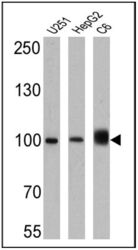
- Experimental details
- Western blot analysis of Importin beta-1 was performed by loading 25 µg of U251 (lane 1), HepG2 (lane 2) and C6 (lane 3) cell lysates onto an SDS polyacrylamide gel. Proteins were transferred to a PVDF membrane and blocked at 4ºC overnight. The membrane was probed with an Importin beta-1 monoclonal antibody (Product # MA3-070) at a dilution of 1:50 overnight at 4°C, washed in TBST, and probed with an HRP-conjugated secondary antibody for 1 hr at room temperature in the dark. Chemiluminescent detection was performed using Pierce ECL Plus Western Blotting Substrate (Product # 32132). Results show a band at ~97 kDa.
- Submitted by
- Invitrogen Antibodies (provider)
- Main image
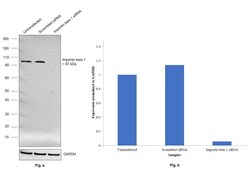
- Experimental details
- Knockdown of Importin beta-1 was achieved by transfecting HeLa with Importin beta-1 specific siRNAs (Silencer® select Product # s7917, s7918). Western blot analysis (Fig. a) was performed using Whole cell extracts from the Importin beta-1 knockdown cells (lane 3), non-targeting scrambled siRNA transfected cells (lane 2) and untransfected cells (lane 1). The blot was probed with Importin beta-1 Monoclonal Antibody (3E9) (Product # MA3-070, 1:5000 ) and Goat anti-Mouse IgG (H+L) Superclonal™ Recombinant Secondary Antibody, HRP (Product # A28177, 1:4000). Densitometric analysis of this western blot is shown in histogram (Fig. b). Decrease in signal upon siRNA mediated knock down confirms that antibody is specific to Importin beta-1.
- Submitted by
- Invitrogen Antibodies (provider)
- Main image
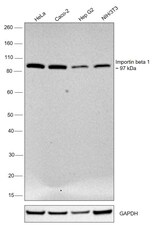
- Experimental details
- Western blot was performed using Anti-Importin beta-1 Monoclonal Antibody (3E9) (Product # MA3-070) and a 97kDa band corresponding to Importin beta-1 was observed across 4 cell lines. Whole cell extracts (30 µg lysate) of HeLa (Lane 1), Caco-2 (Lane 2), Hep G2 (Lane 3), NIH/3T3 (Lane 4) were electrophoresed using NuPAGE™ 4-12% Bis-Tris Protein Gel (Product # NP0321BOX). Resolved proteins were then transferred onto a Nitrocellulose membrane (Product # IB23002) by iBlot® 2 Dry Blotting System (Product # IB21001). The blot was probed with the primary antibody ( 1:5,000) and detected by chemiluminescence with Goat anti-Mouse IgG (H+L) Superclonal™ Recombinant Secondary Antibody, HRP (Product # A28177, 1:4000) using the iBright FL 1000 (Product # A32752). Chemiluminescent detection was performed using Novex® ECL Reagent Kit (Product # WP20005).
Supportive validation
- Submitted by
- Invitrogen Antibodies (provider)
- Main image
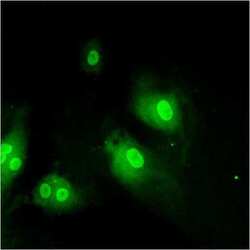
- Experimental details
- Immunofluorescent analysis of Importin beta-1 using anti-Importin beta-1 monoclonal antibody (Product # MA3-070) shows staining in HMVEC Cells.
- Submitted by
- Invitrogen Antibodies (provider)
- Main image
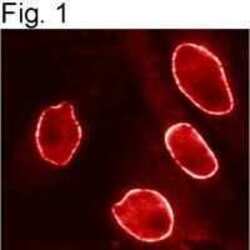
- Experimental details
- Immunolocalization of NTF97 in PTK cells using Product # MA3-070
- Submitted by
- Invitrogen Antibodies (provider)
- Main image
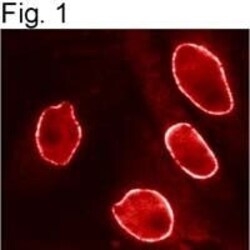
- Experimental details
- Immunolocalization of NTF97 in PTK cells using Product # MA3-070
- Submitted by
- Invitrogen Antibodies (provider)
- Main image
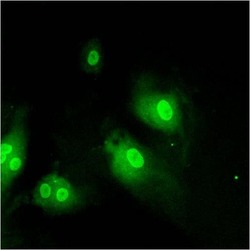
- Experimental details
- Immunofluorescent analysis of Importin beta-1 using anti-Importin beta-1 monoclonal antibody (Product # MA3-070) shows staining in HMVEC Cells.
- Submitted by
- Invitrogen Antibodies (provider)
- Main image
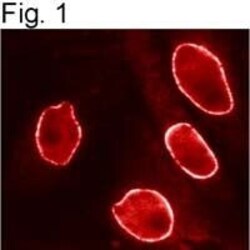
- Experimental details
- Immunolocalization of NTF97 in PTK cells using Product # MA3-070
Supportive validation
- Submitted by
- Invitrogen Antibodies (provider)
- Main image
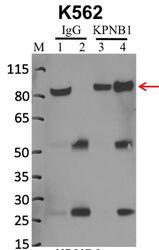
- Experimental details
- Immunoprecipitation of KPNB1 was performed on K562 cells. Antigen-antibody complexes were formed by incubating approximately 500 µg whole cell lysate with 5 µg of KPNB1 monoclonal antibody (Product # MA3-070) rotating 60 min at RT. The immune complexes were captured on 625 µg of anti-mouse coated Dynabeads (Product # 11202D), washed extensively, and eluted with NuPAGE™ LDS Sample Buffer (Product # NP0007). Samples were resolved onto NuPAGE™ 4-12% Bis-Tris gel (Product # NP0335BOX). Lanes 1 and 3 are input and lanes 2 and 4 are IP. Proteins were transferred to PVDF membrane (Product # IB23001). Membrane was blocked in 5% milk. Target was detected using a KPNB1 monoclonal antibody (Product # MA3-070) at a dilution of 1:2000, followed by a 1:4000 dilution of secondary antibody. Chemiluminescent detection was performed using ECL Western Blotting Substrate (Product # 32106). Data courtesy of the Yeo lab as part of the ENCODE project (www.encodeproject.org).
Supportive validation
- Submitted by
- Invitrogen Antibodies (provider)
- Main image
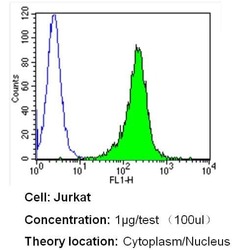
- Experimental details
- Flow cytometry analysis of Importin beta-1 in Jurkat cells (green) compared to an isotype control (blue). Cells were harvested, adjusted to a concentration of 1-5x10^6 cells/mL, fixed with 2% paraformaldehyde and washed with PBS. Cells were blocked with a 2% solution of BSA-PBS for 30 min at room temperature and incubated with a Importin beta-1 monoclonal antibody (Product # MA3-070) at a dilution of 1 µg/test for 40 min at room temperature. Cells were then incubated for 40 min at room temperature in the dark using a Dylight 488-conjugated secondary antibody and re-suspended in PBS for FACS analysis.
- Submitted by
- Invitrogen Antibodies (provider)
- Main image
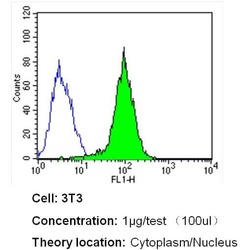
- Experimental details
- Flow cytometry analysis of Importin beta-1 in NIH-3T3 cells (green) compared to an isotype control (blue). Cells were harvested, adjusted to a concentration of 1-5x10^6 cells/mL, fixed with 2% paraformaldehyde and washed with PBS. Cells were blocked with a 2% solution of BSA-PBS for 30 min at room temperature and incubated with a Importin beta-1 monoclonal antibody (Product # MA3-070) at a dilution of 1 µg/test for 40 min at room temperature. Cells were then incubated for 40 min at room temperature in the dark using a Dylight 488-conjugated secondary antibody and re-suspended in PBS for FACS analysis.
- Submitted by
- Invitrogen Antibodies (provider)
- Main image
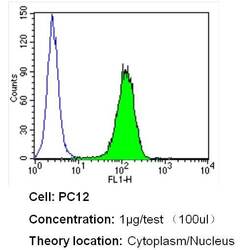
- Experimental details
- Flow cytometry analysis of Importin beta-1 in PC12 cells (green) compared to an isotype control (blue). Cells were harvested, adjusted to a concentration of 1-5x10^6 cells/mL, fixed with 2% paraformaldehyde and washed with PBS. Cells were blocked with a 2% solution of BSA-PBS for 30 min at room temperature and incubated with a Importin beta-1 monoclonal antibody (Product # MA3-070) at a dilution of 1 µg/test for 40 min at room temperature. Cells were then incubated for 40 min at room temperature in the dark using a Dylight 488-conjugated secondary antibody and re-suspended in PBS for FACS analysis.
- Submitted by
- Invitrogen Antibodies (provider)
- Main image
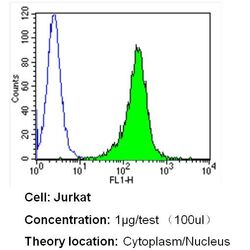
- Experimental details
- Flow cytometry analysis of Importin beta-1 in Jurkat cells (green) compared to an isotype control (blue). Cells were harvested, adjusted to a concentration of 1-5x10^6 cells/mL, fixed with 2% paraformaldehyde and washed with PBS. Cells were blocked with a 2% solution of BSA-PBS for 30 min at room temperature and incubated with a Importin beta-1 monoclonal antibody (Product # MA3-070) at a dilution of 1 µg/test for 40 min at room temperature. Cells were then incubated for 40 min at room temperature in the dark using a Dylight 488-conjugated secondary antibody and re-suspended in PBS for FACS analysis.
- Submitted by
- Invitrogen Antibodies (provider)
- Main image
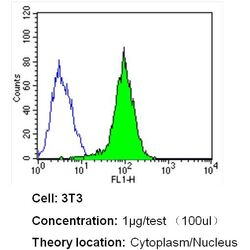
- Experimental details
- Flow cytometry analysis of Importin beta-1 in NIH-3T3 cells (green) compared to an isotype control (blue). Cells were harvested, adjusted to a concentration of 1-5x10^6 cells/mL, fixed with 2% paraformaldehyde and washed with PBS. Cells were blocked with a 2% solution of BSA-PBS for 30 min at room temperature and incubated with a Importin beta-1 monoclonal antibody (Product # MA3-070) at a dilution of 1 µg/test for 40 min at room temperature. Cells were then incubated for 40 min at room temperature in the dark using a Dylight 488-conjugated secondary antibody and re-suspended in PBS for FACS analysis.
- Submitted by
- Invitrogen Antibodies (provider)
- Main image
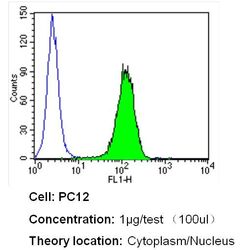
- Experimental details
- Flow cytometry analysis of Importin beta-1 in PC12 cells (green) compared to an isotype control (blue). Cells were harvested, adjusted to a concentration of 1-5x10^6 cells/mL, fixed with 2% paraformaldehyde and washed with PBS. Cells were blocked with a 2% solution of BSA-PBS for 30 min at room temperature and incubated with a Importin beta-1 monoclonal antibody (Product # MA3-070) at a dilution of 1 µg/test for 40 min at room temperature. Cells were then incubated for 40 min at room temperature in the dark using a Dylight 488-conjugated secondary antibody and re-suspended in PBS for FACS analysis.
Supportive validation
- Submitted by
- Invitrogen Antibodies (provider)
- Main image
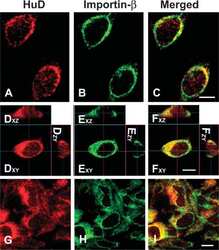
- Experimental details
- NULL
- Submitted by
- Invitrogen Antibodies (provider)
- Main image
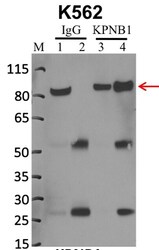
- Experimental details
- RNA immunoprecipitation (RIP) western of KPNB1 was performed on K562 cells. Antigen-antibody complexes were formed by incubating approximately 500 µg whole cell lysate with 5 µg of KPNB1 monoclonal antibody (Product # MA3-070) rotating 60 min at RT. The immune complexes were captured on 625 µg of anti-mouse coated Dynabeads (Product # 11202D), washed extensively, and eluted with NuPAGE™ LDS Sample Buffer (Product # NP0007). Samples were resolved onto NuPAGE™ 4-12% Bis-Tris gel (Product # NP0335BOX). Lanes 1 and 3 are input and lanes 2 and 4 are IP. Proteins were transferred to PVDF membrane (Product # IB23001). Membrane was blocked in 5% milk. Target was detected using a KPNB1 monoclonal antibody (Product # MA3-070) at a dilution of 1:2000, followed by a 1:4000 dilution of secondary antibody. Chemiluminescent detection was performed using ECL Western Blotting Substrate (Product # 32106). Data courtesy of the Yeo lab as part of the ENCODE project (www.encodeproject.org).
- Submitted by
- Invitrogen Antibodies (provider)
- Main image
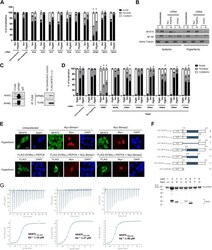
- Experimental details
- Fig. 3. Identification of nuclear import receptor for NFAT5. (A) Quantitative analysis of subcellular localization of FLAG fusion protein fluorescence signal in HeLa cells transfected with FLAG-NFAT5 132-264 PEPCK and siRNA targeting the indicated members of the Kapbeta family, followed by treatment with isotonic (Iso) or hypertonic (Hyper) medium for 90 min. Cells were stained with FLAG antibody and FITC-labeled secondary antibody, then counterstained with DAPI. At least 100 cells were scored in each condition. Data are presented as mean+-s.e.m. of three independent experiments. (B) Western blotting analysis showing cytoplasmic (C) and nuclear (N) distribution of endogenous NFAT5 in HeLa cells transfected with siRNA targeting KPNB1 under different extracellular tonicities. NF-90 and alpha-tubulin antibodies were used as nuclear and cytoplasmic markers, respectively. Blots are representative of three independent experiments. (C) Left: co-immunoprecipitation analysis of KPNB1 and NFAT5. Immunoprecipitation was carried out using anti-KPNB1 antibodies, and immunocomplexes were subjected to western blot analysis using the NFAT5 and KPNB1 antibodies. Crude input lysate (5% total lysate) and IgG-only samples are shown as controls. Right: co-immunoprecipitation analysis of FLAG-NFAT5 132-581 and KPNB1. Immunoprecipitation (IP) was carried out using anti-FLAG affinity resin, and immunocomplexes were subjected to western blot analysis using the KPNB1 and FLAG antibodies. Blots shown a
 Explore
Explore Validate
Validate Learn
Learn Western blot
Western blot